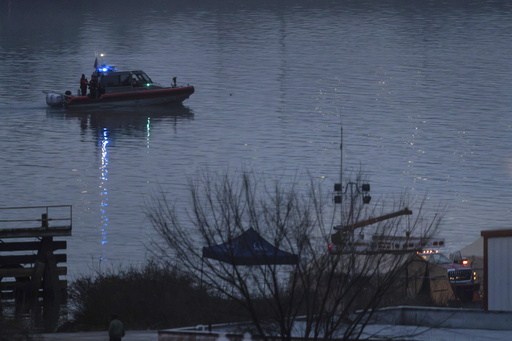Just one day prior to a tragic midair collision at Reagan National Airport near Washington, D.C., Federal Aviation Administration (FAA) employees received a proposal offering them the option to resign with a severance package equivalent to eight months’ salary.
The union representing air traffic controllers advised its members against accepting the resignation offer delivered on Tuesday, explaining that the FAA had not clarified which positions were included in this plan. An official from the Office for Personnel Management, the human resources division of the federal government, stated that air traffic controllers were excluded from this resignation offer and not affected by the hiring freeze affecting other federal employees.
The horrific crash on Wednesday claimed the lives of all 67 individuals aboard an American Airlines plane and an Army helicopter. This incident has intensified scrutiny on the implications of President Donald Trump’s agenda to reduce the size of the federal workforce.
While there is no proof that the White House’s focus on downsizing contributed to the collision, the concern over air traffic controller shortages has persisted long before Trump’s administration. Aviation safety veterans express that those pursuing significant reforms in the federal workforce should remain cognizant of the critical nature of air travel safety.
James Hall, a former head of the National Transportation Safety Board during President Bill Clinton’s administration, emphasized the importance of maintaining effective institutions. “The American public enjoys the safest aviation system in the world. While I believe there’s room for restructuring government, one must heed the old saying to look before you leap,” he remarked.
As investigations into the crash commenced, FAA employees received an email suggesting they consider leaving their positions for potentially more rewarding careers elsewhere. The memo from OPM proclaimed, “The path to improved American prosperity is through encouraging transitions from less productive public sector roles to more productive private sector jobs.”
An OPM official, who requested anonymity in order to discuss confidential internal matters, clarified that air traffic controllers are exempt from the hiring freeze established by Trump upon taking office on January 20, and reiterated that they were not eligible for the buyout, despite being sent the dismissal offer. It remains unclear whether the controllers have been informed of their exemption by OPM. Subsequently, the National Air Traffic Controllers Association advised its members in an email to refrain from submitting resignation requests until further details are disclosed.
NATCA President Nick Daniels indicated that the union had not received adequate clarification on how the resignation program might impact its members. He articulated concern regarding how such a program could potentially threaten public safety, as well as the overall efficiency and capacity of air traffic control, particularly in light of acknowledged staffing shortages.
Despite the administration’s assurances about safeguarding public safety with their budget-reduction initiatives, their approach has been broad rather than precise. Elon Musk, the CEO of Tesla and SpaceX, has been appointed to spearhead the downsizing efforts and has vocalized that “bureaucracy is killing America,” advocating for sweeping workforce reductions. Furthermore, Trump’s administration has prioritized personal allegiance to the president in making federal hiring decisions.
During the campaign, Musk called for the resignation of FAA Administrator Michael Whitaker, who had conflicting views with Musk regarding SpaceX regulations, leading to Whitaker’s resignation on the eve of Trump’s inauguration. This left the FAA without a leader until Trump appointed an acting head after the collision incident was reported.
In the aftermath of the crash, Trump attributed some blame to diversity hiring practices, alleging that preceding administrations had relaxed standards for the sake of meeting racial or other quotas. His government criticized an FAA diversity policy implemented during his earlier time in office.
Despite the administration’s rhetoric about reducing federal personnel, there has been a long-standing struggle to onboard new air traffic controllers. The FAA has faced considerable challenges in balancing the rising volume of commercial flights while maintaining a flawless safety record since 2009. In response, Biden had advocated for funding to hire an additional 2,000 controllers and announced the onboarding of 1,800 controllers by September.
According to an FAA report, air traffic control staffing at the airport during the crash incident was below normal levels; one controller was managing duties typically handled by two individuals at that time. It was noted that merging controller roles is sometimes unavoidable during breaks, shift transitions, or lower traffic periods.
Don Kettl, an emeritus professor specializing in public policy, warned that attracting the much-needed air traffic controllers might become even more difficult now, underscoring the uncertainty that has surrounded the organization’s changes. “When there’s so much unpredictability and the president seems to have placed blame on them, it will certainly complicate efforts to hire more controllers,” he stated.
Kettl further cautioned that a variety of demanding positions within the government, such as food safety inspectors and healthcare professionals in veterans’ hospitals, are already challenging to fill and may face increased obstacles moving forward. He concluded, “The fabric of government is intertwined with our daily lives. If you undermine its capabilities, you diminish its effectiveness.”




